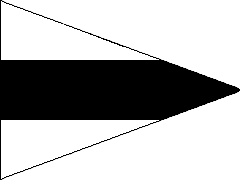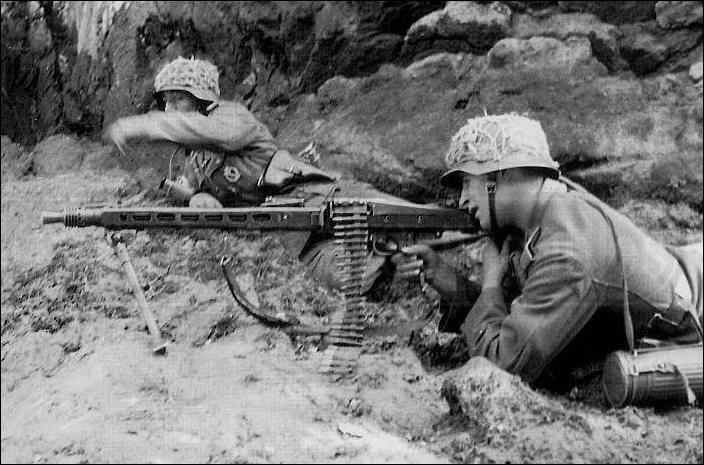At the beginning of the war
infantry regiments and battalions were called just that: Infanterie-Regiment
and Infanteriebataillon. Rifle companies were called
Schützenkompanie. In
1942 all infantry regiments were retitled as Grenadier-Regimenter
(grenadier regiments), an honorific
recalling the army of Frederick the Great. Battalions and
companies were similarly retitled. Regiments of light
infantry
divisions were called
Jäger-Regiment and those of mountain infantry divisions were called
Gebirgsjäger-Regiment.
(Jäger
is the traditional German term for light infantry.)
Those of the Volksgrenadier divisions raised in
1944-45 were called Volksgrenadier-Regiment.
● ● ●
The infantry regiment was the building
block of the
World War II German infantry division.
At the beginning of the war all infantry divisions had three
infantry regiments, each with three battalions plus an
infantry gun company, an antitank company, a reconnaissance
platoon and a pioneer (combat engineer) platoon. It thus
replicated on a smaller scale the triangular organization of
the infantry division—this in conformity with the German
military doctrine of Einheit (unity), which held that
units at each level of command should embody all the
capabilities necessary to accomplish their missions.
The infantry regiments of the 35
infantry divisions of the peacetime army—the 1st Wave— had
an authorized strength of 3,106 men. As additional divisions
were mobilized in 1938-39, personnel and equipment shortages
resulted in various minor organizational changes. For
example, while the regiments of the 1st Wave had 50mm and
81mm mortars, those of the 2nd through 4th Waves had none
initially, such weapons being in short supply. In general,
however, the infantry regiment retained its prewar
configuration up to 1943.

Command pennant for an
infantry battalion commander
The basic unit of the infantry
regiment was the rifle company, of which it had nine: three
per battalion. Each battalion also had a machine gun company
with heavy machine guns (HMG) and 81mm mortars. The
rifle company had 167 men and was organized with a headquarters
section and signal detachment, an antitank rifle section (3 x ATR), an
HMG section (2 x HMG),
three rifle platoons and the company trains (transportation
for ammunition, rations and baggage). The rifle
platoon had a headquarters section, four rifle
squads and a light mortar section (1 x 50mm mortar). The squad had a squad leader, a seven-man rifle
section and a two-man LMG section (1 x LMG). The machine
gun company had 163 men and was organized with a headquarters section and signal
detachment, two HMG platoons (each with 4 x HMG), a mortar
platoon (6 x 81mm mortar) and the company trains.
It should be noted
that the LMG and HMG were the same weapon: in 1939 the
7.92mm MG 34 machine gun. When equipped with a bipod and
sling it was classed as an LMG; when provided with a tripod
and telescopic sight it was classed as an HMG. Later in the
war the MG34 was supplemented, though never entirely
replaced, by the even better MG42. The ATR was
the
Panzerbüchse 38
or 39,
firing a high-velocity 7.92mm armor-piercing projectile.
They were effective against targets with thin armor but not
against medium and heavy tanks, and were eventually replaced
by antitank rocket launchers (ATRL) and the Panzerfaust
weapon.
The regimental infantry gun (IG)
company of 1st Wave infantry divisions had 2 x 150mm IG
and 6 x 75mm IG. These weapons were used for direct fire on
targets visible to the gun crews. However, only the 1st Wave
regiments had 150mm IG; the rest received two additional
75mm IG instead. The regimental antitank (AT) company had
12 x 37mm antitank gun (ATG), 4 x LMG, and was motorized.
The regimental messenger/reconnaissance platoon could be mounted on
either horses or
bicycles. The pioneer (combat engineer) platoon, a signals platoon
and the regimental band (used as stretcher bearers in
combat) were directly attached to the regimental
headquarters.
Wartime modifications to the
organization of the infantry regiment were made either to
incorporate new weapons or to economize on manpower. For the
13th and 14th Wave infantry divisions (raised in late
1940-early 1941) personnel and equipment
shortages compelled the deletion of the regimental infantry gun companies, the
reduction of the regimental antitank companies to
platoon strength (3 x 37mm ATG) and the deletion of the 81mm mortar
platoons from the machine gun companies. The intention in such cases was to bring
the regiments up to full strength when resources became
available, and sometimes this was done. But by 1943, with
the manpower crisis peaking, almost all infantry divisions
were far below authorized strength. This forced the Army
drastically to reduce the size of the infantry divisions,
with many of the cuts falling on the infantry regiment.

German infantry MG 42
machine gun team. (Bundesarchiv)
The Type 1944 Grenadier-Regiment
had an authorized strength of 1,987 men—an overall 38%
reduction in manpower and a 45% reduction in infantry
strength. One battalion was deleted and the other two were
reduced from 850 to 708 men—mainly by reducing the rifle
platoons from four to three squads. On the other hand, the number
of heavy and light machine guns in the regiment was
increased from 111 to 137, the antitank rifles were replaced
by 36 x Raketenpanzerbüchse
54 antitank
rocket launchers (ATRL),
similar to the US bazooka, and 8 x 120mm mortar
were added. This trend continued with the Volksgrenadier-Regiment, whose strength was cut to 1,854 men but had 54
x ATRL and a
major increase in automatic weapons thanks to the
introduction of the StG 44 assault rifle, a fully automatic
weapon that was devastatingly effective at close range. In
addition the Panzerfaust, a
one-shot disposable infantry antitank weapon that could
disable or destroy any tank, was issued on a large scale.
In the VG regiment, the rifle
company was organized with a 20-man headquarters section,
two 33-man assault platoons and one 33-man rifle platoon.
Each platoon had 3 x LMG, and two of
the three squads in the assault platoons were armed with the
StG
44. Even so, the VG regiment had about 20% less firepower than the Type 1944
regiment, this due to a further reduction in
manpower: 128 men versus 148 in the rifle companies. This
reduction was achieved by eliminating the company HMG
section.
The final revision to the organization of the standard
infantry regiment was promulgated early in 1945. The
Type 1945 Grenadier-Regiment was based on the
VG regiment, albeit with fewer StG 44 assault rifles. Few if any
regiments underwent this reorganization before Germany’s
collapse.
One additional feature of the
German infantry regiment is deserving of mention: its supply
unit, called the light infantry column. Unlike the similar
supply units of US and British infantry divisions, the light
infantry column was an organic part of the regiment it
served, furnishing the regiment with all supplies except
rations. The light infantry column received ammunition, equipment,
etc. from the divisional supply columns, then established
distribution points at which the regiment’s units
could draw supplies. Early in the war the light infantry
column was “mixed mobility”: partly motorized, partly
horse drawn. By late 1943, however, the shortage of motor
vehicles was so acute that almost all supply columns in the
infantry division were horse drawn.